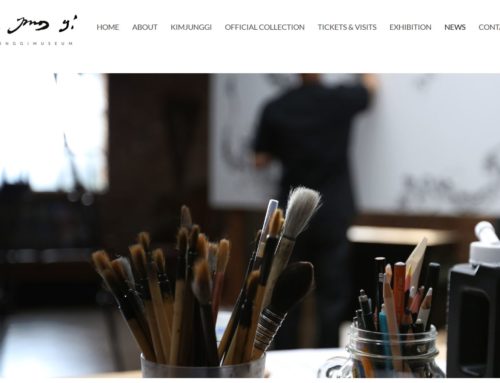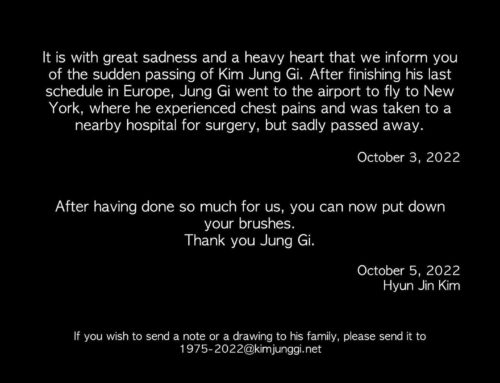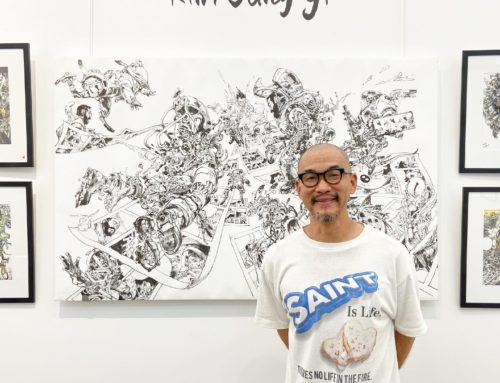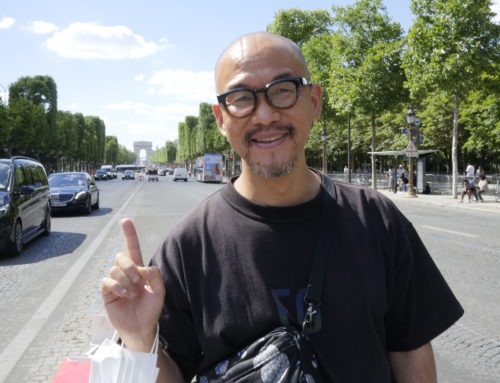Comic King Magazine (Malaysia) – Octobre 2012
1) What is your vision as you joined the ever-competitive industry of comic illustration in the first place?
-When I was younger my aim was to astonish the fellow artists, and didn’t care too much about the public. Well, now I think I was just being too arrogant. I’m proud of my job and wish to create works that not only Koreans but also foreign readers can appreciate.
2) You are a major of Western Art Illustration during your university years and decided to make a career-switch as an comical art illustrator once you graduated from the uni. What is the very reason behind the switch?
-I did enter an art school, but dropped out in my 3rd year because I wanted to be a cartoonist. Colleges and universities were just starting to establish Cartooning Departments at the time but I went to study Fine Art anyway. I admit the art school education was a big help. College preparatory practices (which is, first-hand observation drawings and water colors of still life, figure, and classical sculptures such as bust of Venus or Agrippa.) is relevant to what you do as a cartoonist or an illustrator.After quitting school I went to join a cartooning team. It’s sort of a weird way of working that I believe to exist in Korea only. A bunch of people gather up in a division-of-labor kind of system to create as many pages of cartoon as possible in a given time. Of course I was looking for money. I took figure-drawing part in the team and met my wife there.Meanwhile I prepared portfolio and visited about ten publishers. Not one of them offered me a job; they said my works were out of style. I remember that Japanese cartoon style was dominatingly popular back then. One of the publishers even suggested that I change my style. For a month I couldn’t grab a pencil. I was only thinking what to do, and what I should do. After a year I visited the same publishers with almost exactly same portfolio and every single one of them offered me a job. Things had dramatically changed in a year. I was twenty seven then.
3) What is your biggest motivation that driven you to this far (until today)?
-Ever since I was young, I liked to draw and excelled in it (sorry to brag!). One day I saw this amazing sketch book cover with a fish flying in the air and a girl wearing a swimming goggles. I was absolutely mesmerized by the image and decided to devote my life to create works with such impact and appeal. Afterwards I got to learn that the cover was an illustration extracted from Doctor Slump by Toriyama Akira.
4) Where do you draw the biggest inspiration from to your artworks?
-I draw the subjects of my interest. Let’s say I watch F1 game, and my works will be about F1 for the next couple of days. I’ve done it this way all the while and it made me have an experience of drawing pretty much all sorts of things. I do enjoy working on sensational subjects, such as sex, crime and war. My favorite movie is Seven by David Fincher. I would like to create a cartoon of similar style some day.
5) Who is your favorite illustrator / comic artist whom inspire you the most and greatly influenced the style of your artworks? and how did he / she inspire you in any sort of way? (e.g: the lining, plot, conceptual design of it’s artworks)
-I admire works of Toriyama Akira and Otomo Katshiro. As a high school kid, I was highly influenced by The Dragon Ball. I remember the pain in my heart I had after reading Akira. I could only wonder how it was possible to create such a work. After entering college I became familiar with Asian cartoonists such as Siro Masamune, Seyoung Oh, Samura Hiroyaki, and Ikegami Ryoichi. I also esteem highly of works by Mobius, Richard Koben, Simon Bisley, Adam Hughes, Norman Rockwell, James Harren, Robert Fawcett, James Jean, and Tedrada Katsya. Samura Hiroyaki knows how to play with the lines. Mobius is apt at visualizing a vast space with rough but highly sophisticated details. Richard Koben is skillful in depicting light and color. Simon Bisley’s hyper-macho rendering of male body impresses me. Adam Hughes’ figure expressions are very realistic but stylistic at same time. Norman Rockwell is one of my favorite, as well; I often observe his works and study how he had harmonized the composition and the underlying stories. Terada Katsya makes me think of the correlation of Eastern and Western styles of art. The way James Jean combines fine art and cartoonish expressions inspires me. I have recently started Facebook and it opened my eyes to the great diversity of artists. There are truly too many talented artists and I always get motivated by them.
6) How is like by taking art illustration as your full time profession?
-It is surprising and exciting that many people look at my works. But as a professional illustrator, I don’t get to work on my favorite subject all the time. I have to meet my clients’ demands. To know how to apply one’s style to each occasion is also a talent.
7) Can you describe the daily routine of a professional illustration artist like you?
-My studio is located in my academy. I am a co-principal of this independent college preparatory academy for cartoon&animation major. I arrive at the studio by noon, turn on the computer and collect photographs for the visual resource. As I go through the collection of photographs I try to memorize all the important parts of the images. I work on this process on daily basis. After that I start working. I keep F1, soccer, or Moto GP game on while I’m working. I work usually 5~6 hours a day. I don’t stay up all night working since I’ve got married— maybe two or three times a month.
8 ) Is there any restriction or taboo in South Korea that forbade you from maximizing the creativity via your artworks?
-Korea isn’t the best country for a cartoonist to live in. There are many limits and taboos for artistic expressions. For example, you don’t see that many adult cartoons. Korean cartoons are highly influenced by Japanese cartoon style but people don’t look at it as a good thing. Things have gotten better, but I wish there could be more freedom in artistic expression.
9) How do you define yourself by profession? A comic artist? An illustrator? A classic artist? A contemporary artist?
-I would like to be called a cartoonist, but when I look at my portfolio I don’t see that many cartoon works. But I still like to be called a cartoonist.
10) Your artworks is just simply superb, we totally can’t believe what we saw, how do you able to materialised a huge artworks with such a superhuman speed, and totally without the assistance of sketching’s process?…
-I have a considerably speedy hand. Quick memorization makes it faster to visualize the images. I started drawing without outlines for educational purpose. As an art school instructor I had to create real-time drawings while the students were watching me. I thought outlines took too much time so I just went on with water color not including preparatory sketch, and it worked. Since then it has become my drawing habit. When you have an image in your head that is strong enough, you don’t really need to rely on outlines… do you?
11) Ever been think of attempting some uphill task, such as illustrate something that never come into your mind before, something that seem impossible or very tough to you?
-I think I can visualize almost up to 70% of the world (or any subject) I have known or seen. Yes, it is a bit difficult for me to draw something that I don’t have information of. I am capable of visualizing fantasy world, but it’s just easier for me to construct reality.
12) What are you up to now ?
-I’m preparing for a cartoon. The story is written by French script-writer Jean-David Morvan. This is one of my favorite genres and I’m enjoying working on it. The complete work will be published, maybe, by this December or next January. I’m also planning to finish a sketch collection for adults by this winter. I tell you it’s for adults; you may get to know how bad I am (at least in my brain, ha ha).
13) Does your jobscope required you to do a lot of travelling (domestically or internationally) ? Where did you mostly spend your time? South Korea or any other specific countries?
-Traveling inspires me a lot. A trip to France this year had a good impact on me. I wish I could’ve been there when I was younger. I’ve been to Japan, Thailand and France, and I’d like to visit other countries if I get a chance. I really want to visit US. I am curious about American comic market and want to meet American comic artists. I may visit America pretty soon, and hope it will be a good stimulation to me as an artist.
14) Is there any difference between South Koreans and foreigners on their perception towards your artworks? If yes, can you tell us how they were set apart by these difference? (e.g: cultural, racial, religious belief & etc…)
-I don’t want to brag but I’m kind of a famous art instructor in Korea. Koreans know me more as an art instructor then as a cartoonist. I’d like to thank all the foreign fans who weigh on the instructional works I had created for students. Korean cartoon had been dominantly under the influence of Japanese cartoon, but now things are shifting towards diversity. My style, which is realistic and demonstrative, has been considered as an ideal sample for Korean college preparatory art. Along with that line it doesn’t seem odd that my art was first discovered and appreciated in college preparatory education market, whether it was my intention or not. I just draw what I like. Through SNS I got to realize that people from other countries also like my works. Such devotions are really encouraging and make me work harder. I’m grateful that I enjoy art this much and I don’t want to stop.
15) What is your opinion towards the current scenario of the comic and illustration art’s industry across South Korea, Asia Region, Euro-America Region or even across the world? (e.g: Optimistic or Pessimistic?)
-It seems that the boundaries are weakened these days. Great ideas of Asian and Western art, design, architecture, music, photography, and film can be melted into a single work of art. An artist needs to be always learning in order to keep up with the world. Computer graphic has made the art-making procedure fun and fast.But my consideration is that works with complex articulations are diminishing. I wish to see expressions of personality and ideas rather than ever-changing, short-lived trends. The world today is a good soil for an artist to advertise him/herself. Debut may have become easier but competition has grown hotter. It’s quite exciting.
16) How’s your family’s response in the first place as you decided to choose art illustration as your profession? Are they supportive of what you are doing for all these years?
-I’m the oldest son of the family, so my parents didn’t allow me to choose art as an occupation (it’s kind of a Korean tradition that the oldest son tend to be the bread winner of the family). The winner of the game turned out to be me, though. Eventually they got to realize I was always doodling with my pencil and never meant to be a scholar. I was a second grader in high school then (translator’s note: equivalent to a sophomore in American school system). Now they understand and support me, but as a kid I often got trouble for doodling on my note book pages. My wife majored in art, as well, so I receive a full support from her.
17) Ever been thinking of grooming your children by fitting him / her into your shoes as he / she grow up?
(The translator wants ask you if the question is about occupation/profession or about general ideas)
-I have two kids: a nine-year-old girl and a six-year-old boy. They do like to draw, but compared to my childhood, they’re not that into it. Given that both of their parents are artists, it’s a little odd. As a father, of course I’d like to see their talent in art.
18) Apart from illustrating artworks, can you tell us how you spend your leisure time?
-I don’t drink or smoke. I may enjoy a glass of coke, though (that’s how bad I can get). My greatest interest is the motorcycle. The mechanical feeling of the bikes captivates me. I’m especially in love with a bike named Ducati. I really want to own it. I have delayed the purchase because of my wife’s opposition, but gradually she has flapped her side to « yes », and yay, I might be able to get it!
19) Any future plan for a visitation to Malaysia and meet up with your fans here?
-I received an invitation from Malaysia lately. It’s always exciting to meet with people who adore my works. I am planning to make my visit in October. Wish to see you there!
20) Any advice for all Malaysian youth whom wished to undertake comic / art illustration as their profession?
-Prevalence of digital cameras made photography approachable to people. Computer graphic and soft wares provide an easy solution to the artists. With the technology, one can draw out the maximum result in a minimal amount of time.As an art instructor I teach young students and it’s pretty obvious that their works are far better than my own childhood works. I do notice that it’s a relevant result since the circumstances have gotten better for artists, but I’m also worried that they have reached the tasty part of it way too early. Of course the frosting tastes good. But when they get to realize that it was only technology, not their own competence or capacity, what should they do?Will they go back to boring and slow « basic principles »? Or just keep running blind with the technology in their hand?I think basics are the most important. I know it’s tedious, painstaking, and bitter. But one should first learn to appreciate the bitterness in order to fully enjoy the sweetness that comes after it. After all, you can’t draw better than what you know. An artist must see, feel, listen, experience, study and collect as much as they can. The cumulated information will eventually lead the artist to create a better work.




